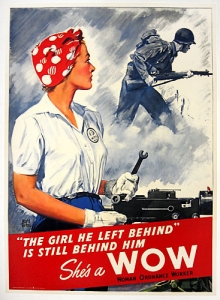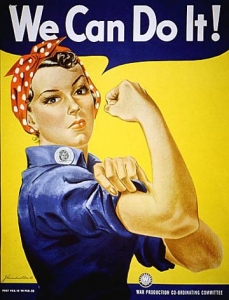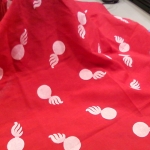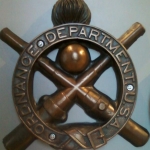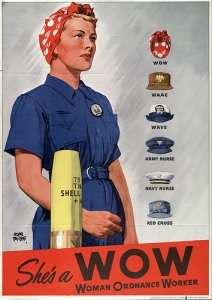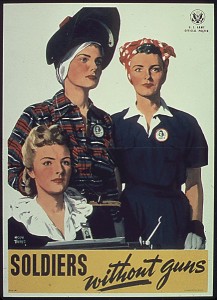Since the Smithsonian Museum promoted J. Howard Miller’s 1942 We Can Do It, a poster of the woman worker with her arm raised and fist clenched, produced by Westinghouse to encourage war production, there have been a variety of interpretations regarding the illustration images of women in the labor force during World War II. These discussion have included Norman Rockwell’s Post cover of Rosie the Riveter and who was the inspiration for what. The two most instructive pieces I’ve read do an admirable job, so I don’t really feel the need to rehash the material they cover.* Nevertheless, I do want to address one seemingly minor aspect of clothing many of these women are pictured wearing while at work: the hair-covering red kerchief with a white dot decoration.
During WWII the American illustrator Adolph Treidler produced at least five posters touting Women Ordnance Workers, otherwise known as WOW’s. These women worked for a variety of companies making ordnance (military materiel including weapons, ammunition, combat vehicles, and maintenance tools and equipment) for use by the various United States armed forces. Treidler’s posters and others like them both stood for and encouraged women to take up these sorts of jobs in the workforce. ** “’She’s a WOW,’ declared a poster showing an attractive young woman looking up from her assembly line at the imagined picture of her man as he headed into combat. As a Woman Ordnance Worker, she was told, she was freeing a man for the fight.”***
Born in Colorado, Adolph Treidler first studied at the San Francisco Institute of Art from 1902 through 1904 and then with Robert Henri in New York. His first illustration work was for McClure’s magazine in 1908. During World War I, Treidler designed Liberty Loan posters and his first working woman poster for the United War Work Campaign. During World War II, in addition to his own poster designs, Treidler was the Chairman of the Pictorial Publicity Committee for the Society of Illustrators.
In each of Treidler’s five WOW posters the women ordnance workers wear a white on red kerchief tied around their heads to protect their hair. Two of those posters (one a variant of the other as they are with and without a shell casing) include a group of women’s hat symbols along the right side of the poster. Each symbol is accompanied by the name of the service they represent. From bottom to top they elucidate the hat styles worn by Red Cross workers, Navy Nurses, Army Nurses, WAVEs, WAACs, and the top symbol is for the WOW. As Treidler illustrated in every WOW poster he created, the designated symbol for the WOW is a red and white handkerchief or a bandanna worn tied over a woman’s hair as a method for keeping their hair out of the machinery and to specifically identify her as a WOW. The pattern on the official WOW kerchief material is not polka dots, but is based on the symbol of the exploding cannon ball that is part of the logo for the U. S. Ordnance Department. When their kerchief was paired with a blue all-purpose coverall, those WOW’s were nothing if not patriotic. Happy Independence Day!
Many thanks to Richard Colton, Interpreter and Park Ranger at the Springfield Armory National Historic Site in Springfield, MA, for terrific information and wonderful photos of and about WOWs.
* For example see, James J. Kimble and Lester C. Olson, “Visual Rhetoric Representing Rosie the Riveter: Myth and Misconception in J. Howard Miller’s ‘We Can Do It!’ Poster” v.9 no. 4 Rhetoric & Public Affairs (2006): 533-570; and Sheridan Harvey, Rosie the Riveter: Real Women Workers in World War II (video presentation, Library of Congress, July 20, 2010). https://www.loc.gov/rr/program/journey/rosie.html
**This was not the first time Treidler created war-support posters. As a poster artist in WWI, perhaps Treidler’s most famous poster was part of the United War Work Campaign and showed a young woman wearing coveralls holding ordnance in one hand and a model of an airplane in the other. This poster bears the words, “For Every Fighter a Woman Worker” and “Care for Her through The YWCA.”
*** William John Bennett, America: the last best hope (Vol. 2) ): From a World at War to the Triumph of Freedom (2007): 208.
June 30, 2011
Joyce K. Schiller, Curator, Rockwell Center for American Visual Studies, Norman Rockwell Museum


